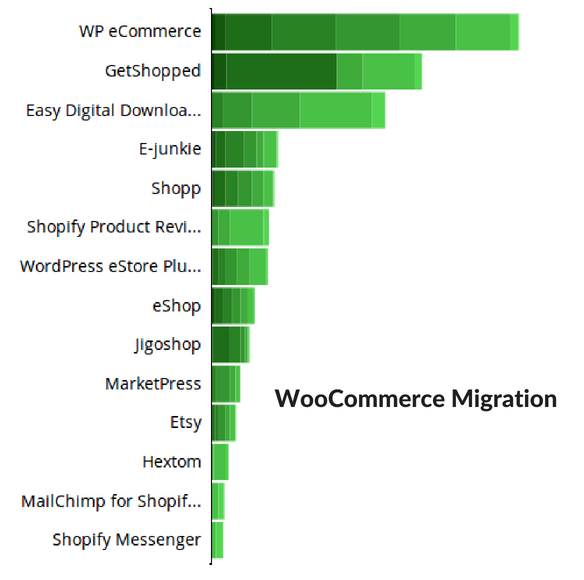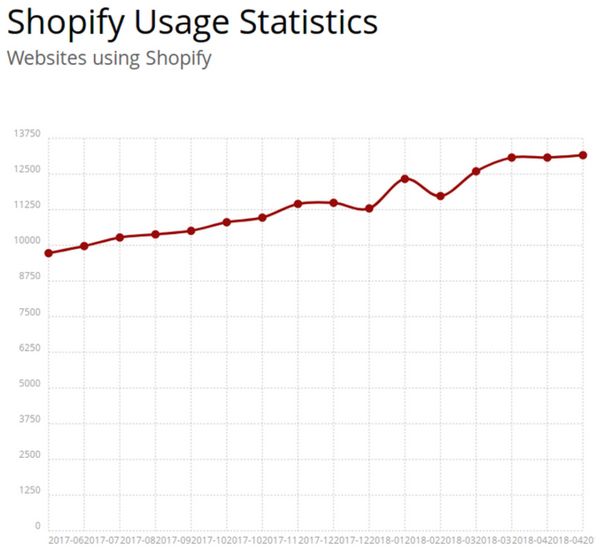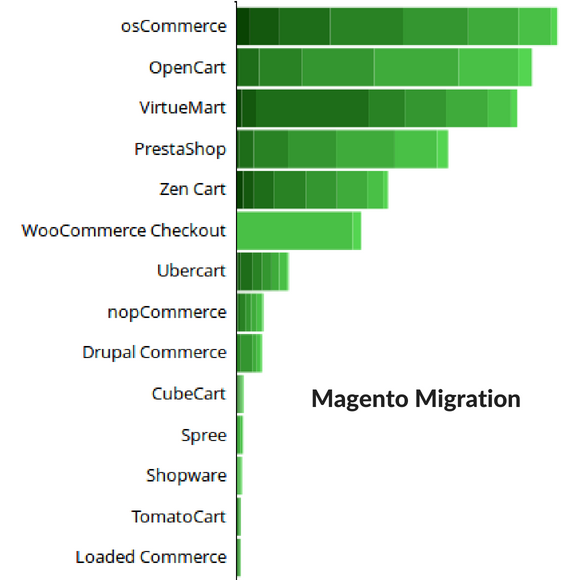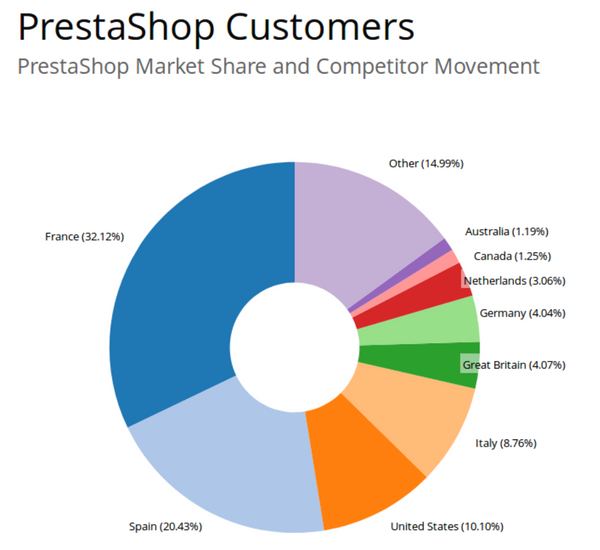
Finding the best shopping cart to run a successful business was always a challenge. It depends on your needs, financial opportunities, store aims, products you sell and final result you want to reach. Cart2Cart has made a research of recent changes in eCommerce platforms market share and uncovers the outlines, regarding official builtwith.com platforms’ usage statistics and internal Cart2Cart migration data from recent years.
ECommerce market nowadays is unexpectedly dynamic and overfilled with new solutions. This invokes existing solutions to make crucial changes and upgrades continuously what, in its turn, causes regular redistribution of eCommerce platform market share. For a smooth transition, consider our Universal eCommerce Migration Checklist.
What makes this article critically special? It is the fact that here Cart2Cart service shares its internal statistics about most popular ecommerce platforms. It gives you access to unique data you won’t stumble upon anywhere else.
ECommerce Platforms Market Share
According to recent Cart2Cart migration statistics, there are 5 top eCommerce platforms that store owners are switching to. They are WooCommerce, Magento, Shopify, PrestaShop, and OpenCart.
Here you can see the chart showing the most worldwide used solutions with eCommerce platforms market share, regarding builtwith.com statistics.

This data correlates with target online retailers users migrate to via Cart2Cart. WooCommerce is an exception. Despite it has one of the biggest migration percentage, it’s not drastically differ from the number of migrations to other top eCommerce platforms, examined in our review.
WooCommerce
According to builtwith.com, WooCommerce is the world’s most widely used shopping cart. It has the highest ECommerce platform market share: there are millions of active online stores created with this awesome WordPress plugin.
Over the last decade, the percentage of migrations to WooCommerce has grown substantially. If you're considering the move, a detailed guide on migrating to WooCommerce can be very helpful. It surpassed migration percentage to Magento, which has seen a significant decrease during this period. It seems that being extra-flexible (sometimes excessively) and not easy in use, Magento is losing some points with years. And WooCommerce, contrary, increases its eCommerce platform market share, being a good SEO-optimized and user-friendly solution both to small and large businesses.
That said, it would be wrong to think that WooCommerce is in any way a direct Magento’s competitor. Serving different business needs and purposes, both platforms can peacefully coexist. WooCommerce has a significant advantage over Magento or Shopify when it comes to design, regarding easiness of customization. Along with WooCommerce native themes, you can use any of WordPress ones to work with your plugin. There are tens of them in the web.
WooCommerce has a significant advantage over Magento or Shopify when it comes to design, regarding easiness of customization. Along with WooCommerce native themes, you can use any of WordPress ones to work with your plugin. There are tens of them in the web.
Here you can see the list of platforms WooCommerce is frequently gaining customers from as stated in builtwith.com statistics.

OpenCart
The official builtwith.com statistics shows another solution among top eCommerce platforms with hundreds of thousands of store owners who are using OpenCart to run their businesses.
Regarding the migration data, we can find out that the popularity of migrating to OpenCart has seen fluctuations. Conversely, the number of users migrating away from OpenCart has grown over the years.
According to builtwith.com, OpenCart has seen a decline in its eCommerce platforms market share. Among top 1 million sites, identified with the highest traffic, its share has declined over the past years, representing only a small percentage of stores created with OpenCart today. This trend is further illustrated in the chart below.

Core-extension model of the platform could be the reason to these changes, because it requires installation of many add-ons if you need higher than basic functionality. For complex needs, consider our migration customization service.
Shopify
Another popular solution is Shopify, which entirely differs from the platforms featured above. Being a hosted cart, it still offers you advanced eCommerce functionality and catches store owners with user-friendliness and ease of use. For those considering the switch, a comprehensive Shopify migration checklist can be invaluable, alongside understanding the benefits of migrating to Shopify. According to builtwith.com Shopify devotedly serves millions of unique stores.
Shopify integration with Amazon is another trick to beat the competitors. In recent years, migrations to Shopify have continued to show strong growth, and one of the reasons for rising Shopify import could be Shopify’s POS system, which was introduced over a decade ago. This fantastic implementation allows managing entire offline store together with online one and POS system can take payments if connected to PayPal. Most other market solutions do not offer this unique top-notch service.
Another reason of such Shopify popularity could be their marketing strategy and many promoting venues they do. Other platforms are not used to spend so much money on PR and advertising.
Here we can see Shopify usage statistics; it has grown significantly over the years. According to builtwith.com, Shopify continues to rapidly increase its eCommerce platforms market share. There is a substantial share of Shopify websites among 1 million with the highest traffic in the world, a trend that has been consistently observed.

Magento
Among most popular eCommerce platforms stays Magento. It has over a hundred thousand active sites according to builtwith.com usage statistics. This progressive eCommerce solution always impresses store owners with new features and capabilities which allow businesses to drive sales and performance.
The platform, now part of Adobe Commerce, has become a turning point in the industry. The evolution from Magento 1 to Magento 2 and beyond has introduced powerful capabilities. For a smooth upgrade, check out our Magento Migration Checklist. Newer versions of Adobe Commerce feature enhanced APIs for deep integration with EPR and PIM systems, advanced B2B functionalities like company accounts and shared catalogs, and robust security measures.
Regular upgrades and bug fixes prove that there is no limit in searching the ways to success.
Despite impressive new features, Magento itself is the most flexible solution available today. It serves as a platform to half of world’s largest online retailers. Magento is a unique eCommerce builder, thoroughly designed by its developers and is widely known to be “the standard of eCommerce industry”.

As you can see above, most of the platforms web store owners are switching from are open-source. The obvious reasons for migration to Magento are the platform’s top flexibility, unique features, and strong SEO-optimization.
Magento is the solution with the longest ‘life cycles’ store owners experience. It can be indicated by the amount of Magento upgrades - migrations from Magento to Magento - performed by Cart2Cart users.
According to our internal statistics, users are more likely to upgrade Magento to new versions than to switch it to another solution. It means they are satisfied with Magento community. They just willing a newer version of this super flexible eCommerce builder. This is where Cart2Cart comes to help store owners and offers automated Magento upgrade. The second eCommerce platform that can boast about such loyal store owners is PrestaShop.
PrestaShop
PrestaShop is another leading open-source eCommerce platform available today. It covers over hundreds of thousands of active stores,according to builtwith.com. Percentage of PrestaShop import along with eCommerce platform market share is gradually growing. For instance, the number of migrations to this shopping cart has shown consistent growth over the past decade.
There are no reasons to round on this platform, which is the golden middle between Magento complexity and Shopify simplicity. PrestaShop can boast of such unique features as Intelligent Merchant KPI and Forecasting. They make PrestaShop's statistical facilities very impressive.
One of the reasons that PrestaShop is among top eCommerce platforms could be its integration with marketplaces, which allows exporting product listings straight to eBay, Amazon and other world-known marketplaces.

Migration to Open-source vs Hosted Platforms
The number of migrations to open-source solutions surpasses the quantity of migrations to hosted ones by a significant margin. That says, broader customization possibilities attract rapid platform switching. Understanding the core differences is key when choosing a platform, as seen in the ongoing debate between open-source and hosted carts.
Another reason could be that Shopify is, apparently, the only hosted shopping cart which could compete in functionality with other most popular ecommerce platforms, described here. BigCommerce is the second popular hosted target platform. Even considering past changes to BigCommerce's pricing policy, it has also become one of the best eCommerce solutions for export.
One more interesting insight we want to share is the fact that there has been a significant trend of migrations from open-source to hosted platforms in recent years than vice versa.
Hosted solutions are gaining bigger and bigger popularity, mostly because of Shopify. And lots of new platforms that appear daily are hosted. And in comparison with recent years, modern hosted carts are much more functional and customizable.
Besides, we can claim about the bang of start-ups last few years. There is no doubt, it’s easier for young entrepreneurs to use hosted solution. It requires minimum of tech skills and allows to fully concentrate on the development of product itself, instead of mashing up with code.
Who Will Meet the Greatest Losses?
The development of technologies makes changes to our lives from day to day. We can’t deny it. The recent trends show that open-source shopping carts are slowly (but gradually) conceding the market to hosted ones. The complete domination of hosted platforms is out of reach yet. But the fact that people are likely to use hosted shopping carts tells a lot.
In the light of usage and migration trends, eCommerce solutions like osCommerce, Zen Cart, and Virtuemart are tending to have the decrease in their user base. Thought, there was already the peak of migrations from these platforms, and they still retain a niche in the eCommerce industry.
What about one of top shopping carts today? There is an apprehension that OpenCart is likely to continue losing clients and bow out positions to Shopify and Prestashop.
What Predictions Can We Make?
It is thought that Magento community is going to grow. Particularly, the % of Magento 2 users has increased, as support for Magento 1.x was discontinued years ago. Currently, Magento 2 community is not expanding as fast as was expected. There is high level of user’s dissatisfaction with some changes in second platform’s generation.
Shopify seems to be the ‘all in one’ solution: easy-to-use ‘pure’ eCommerce builder with a bag of unique features. Expectedly, it will augment its community rapidly in next years.
WooCommerce, being the most popular platform nowadays, is predicted to strengthen its positions in future and concur larger market share.
Despite the lost of clients BigCommerce has experienced recently due to changes in pricing policy, it is still a perspective platform with a huge fanbase. And it is likely to get back its eCommerce platform market share in future. It has many benefits it has to offer. For instance, BigCommerce doesn’t have transaction fees and allows store owners to accept payments from around the world with no extra charge, unlike Shopify.
Outline
As you see, the official statistics says most popular eCommerce platforms are usually open-source. We can also admit, that store owners aim to get high and advanced functionality along with user-friendliness.
All platforms presented above are worth to be paid attention to, according to their eCommerce platforms market share,good reputation and set of functions, which make them worldwide used and top eCommerce platforms available today.
We hope that our research was useful to you. In case you feel that your current solution is better to be changed for one of the top platforms, you can use Cart2Cart automated shopping cart migration service for and perform an easy switch.
Cart2Cart service is the #1 automated migration service with more than half a million successful migrations behind its back. It is a remarkably secure way to transfer your eCommerce data from one platform to another accurately and with no technical expertise needed. Explore our security policy to learn more.
With the help of Cart2Cart you can easily migrate your current store to over 250 platforms, including all eCommerce solutions featured in this article.
Feel free to contact Cart2Cart 24/7 support team if you have any migration-related questions.
If you feel that you are ready to switch your current solution to one of best shopping carts, take your chance and perform a Free Demo migration with Cart2Cart here and now.
Monthly Update – December 2025
As 2025 draws to a close, a dominant trend in eCommerce is the rise of immersive shopping experiences, driven by advancements in augmented reality (AR) and virtual reality (VR). Retailers are increasingly leveraging AR to allow customers to virtually 'try on' clothes, place furniture in their homes, or preview products in 3D before making a purchase. This reduces return rates and significantly enhances buyer confidence. Furthermore, the adoption of live commerce events, combining interactive video streaming with real-time purchasing capabilities, is soaring, providing a dynamic and engaging alternative to traditional online browsing. These events are often enhanced with AI-powered recommendations and instant customer support, creating a seamless and personalized shopping journey. For merchants looking to stay competitive, integrating these technologies and optimizing platforms for rich media content and real-time interactions is no longer optional but essential. Embracing these immersive strategies is key to capturing consumer attention and fostering deeper brand engagement in the evolving digital marketplace.
For more details, explore our FAQ section or schedule a call with a migration expert.






Comment by Binance注册奖金
Your point of view caught my eye and was very interesting.
Comment by Salus Structured Silver Gel
Hi there, just became alert to your blog through Google, and found that it is truly informative.
I am gonna watch out for brussels. I will appreciate if
you continue this in future. Many people will be benefited from your writing.
Cheers!
Comment by Iryna Kravchuk
Hello!
Thank you for the commentary! We appreciate your feedback. Maybe there are particular articles you like the most? We would be glad to know your opinion.
Comment by Instacut Garcinia
I really like your writing style, fantastic information, thanks for posting 😀
Comment by Alina Terebetska
Hi there!
Thanks for your feedback! We’re delighted you deem this article useful) Hopefully, we’ll hear from you more)